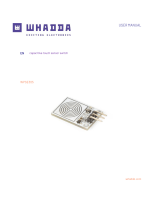
9
KA1 2ASSEMBLYMANUAL
4. Installing the Arduino Library
1. Install the library:
Go to the KA12 download page on the Velleman website:
http://www.vellemanprojects.eu/support/downloads/?code=KA12
Download ‘velleman_KA12’ extract and copy the “velleman_KA12” folder to your Documents\Arduino\libraries.
2. Example sketch:
A. Open the Arduino software
B. Then click le/Examples/Velleman_KA12/Velleman_KA12
3. The code:
#include <Velleman_KA12.h>
int all[24];
int sensor;
void setup() {
Serial.begin(115200);
ka12_init();
}
void loop() {
ka12_readAll(all);
for (int i=0; i < 24; i=i+1) {
Serial.print(i);
Serial.print(“ / “);
Serial.println(all[i]);
}
sensor = ka12_read(1);
Serial.print(“Value sensor 1 :”);
Serial.println(sensor);
delay(1000);
}
4. Line by line
In order to make the KA12’s functions easy to use, we made a library.
Line 1 and 6 declare the use and initialize the library. This must be done in every sketch that uses the KA12. The
library gives you the possibility to easily read all sensor values and save them in an int-array or to read one value
and save this to an int.
To read all sensors you should declare an int-array with 24 places (line 2). To ll the array we use the readAll
command (line 8). In the example we display all the values to the serial monitor using a for loop (line 9 to 12).
The serial communication is set up in line 5.
If you only need one value you can use the “ka12_read” command (line 13).












